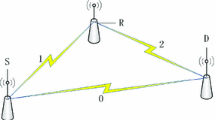Abstract
This paper presents the performance of cooperative ARQ schemes in Nakagami-m fading networks, where coherent equal gain code combining is adopted to combine the retransmitted signals at the destination. Two different retransmission protocols are adopted upon the reception failure of the destination. Once the relay node can decode correctly, the retransmission will be performed by relay in protocol I or the better node between source and relay in protocol II, where the better means having a better channel to the destination. By approximating the product of two independent Nakagami-m random variables to the sum of two independent gamma random variables, the performance of protocol I is derived at high signal-to-noise ratio (SNR). We further develop the approximation for the product of two maximum Nakagami-m random variables, which is employed to obtain the performance of protocol II at high SNR. The reliability of theoretical analysis is validated by simulation results, where the advantages of these two protocols upon the conventional protocols are presented.
Similar content being viewed by others
References
Laneman J. N., Tse D. N. C., Wornell G. W. (2004) Cooperative diversity in wireless networks: Efficient protocols and outage behavior. IEEE Transactions on Information Theory 50(12): 3062–3080
Zhao B., Valenti M. C. (2005) Practical relay networks: A generalization of hybrid-ARQ. IEEE Journal on Selected Areas in Communications 23(1): 7–18
Dianati M., Ling X., Naik K., Shen X. (2006) A node-cooperative ARQ scheme for wireless ad hoc networks. IEEE Transactions on Vehicular Technology 55(3): 1032–1044
Le L., Hossain E. (2008) An analytical model for ARQ cooperative diversity in multihop wireless networks. IEEE Transactions on Wireless Communications 7(5): 1786–1791
Yu G., Zhang Z., Qiu P. (2006) Cooperative ARQ in wireless networks: Protocols description and performance analysis. IEEE International Conference on Communications 8: 3608–3614
Liu Q., Zhou S., Giannakis G. B. (2004) Cross-layer combining of adaptive modulation and coding with truncated ARQ over wireless links. IEEE Transactions on Wireless Communications 3(5): 1746–1755
Chen Q., Fan P. (2005) Performance analysis of hybrid ARQ with code combining over interleaved Rayleigh fading channel. IEEE Transactions on Vehicular Technology 54(3): 1207–1214
Alouini M. S., Abdi A., Kaveh M. (2001) Sum of gamma variates and performance of wireless communication systems over Nakagami fading channels. IEEE Transactions on Vehicular Technology 50(6): 1471–1480
Alouini M. S., Simon M. K. (2001) Performance analysis of coherent equal gain combining over Nakagami-m fading channels. IEEE Transactions on Vehicular Technology 50(6): 1449–1463
Bletsas A., Khisti A., Reed D. P., Lippman A. (2006) A simple cooperative diversity method based on network path selection. IEEE Journal on Selected Areas in Communications 24(3): 659–672
Noh K.-L., Serpedin E., Suter B. (2007) Optimum cooperation of the cooperative coding scheme for frequency division half-duplex relay channels. IEEE Transactions Wireless Communications 6(5): 1654–1658
Simon M. K., Alouini M.-S. (2000) Digital communication over fading channels: A unified approach to performance analysis. Wiley, New York
Gradshteyn I. S., Ryzhik I. M. (2000) Table of integrals, series and products, 6th edn. Academic Press, New York
Conan J. (1984) The weight spectra of some short low rate convolutional codes. IEEE Transactions on Communications 32(9): 1050–1053
Author information
Authors and Affiliations
Corresponding author
Rights and permissions
About this article
Cite this article
Xu, W., Lin, J., Niu, K. et al. Performance Analysis of Cooperative ARQ with Code Combining over Nakagami-m Fading Channels. Wireless Pers Commun 54, 559–578 (2010). https://doi.org/10.1007/s11277-009-9740-1
Received:
Accepted:
Published:
Issue Date:
DOI: https://doi.org/10.1007/s11277-009-9740-1




